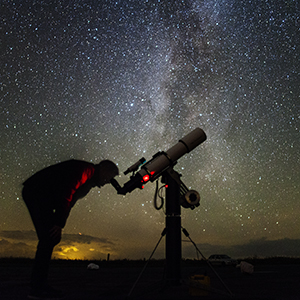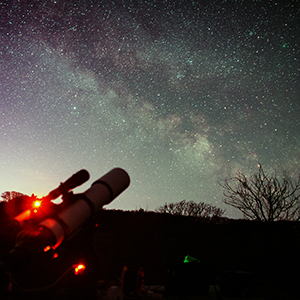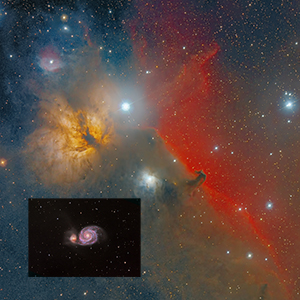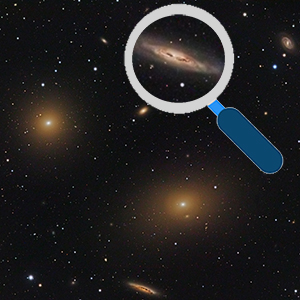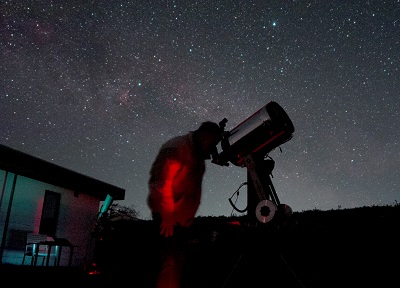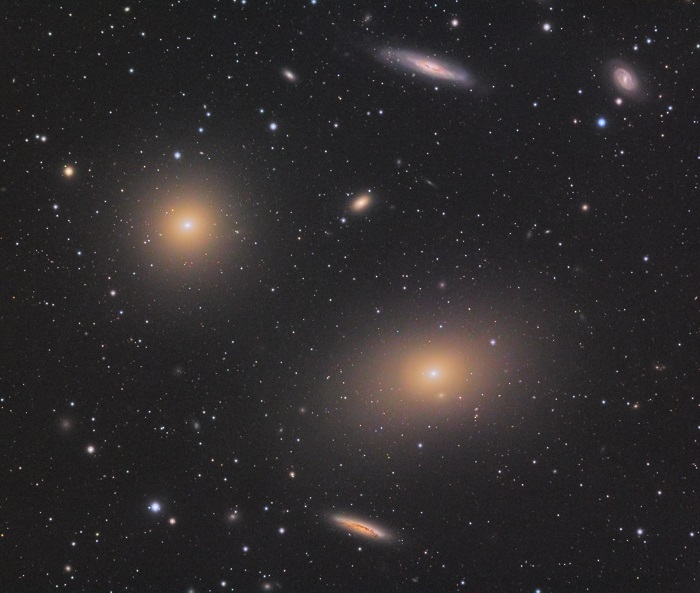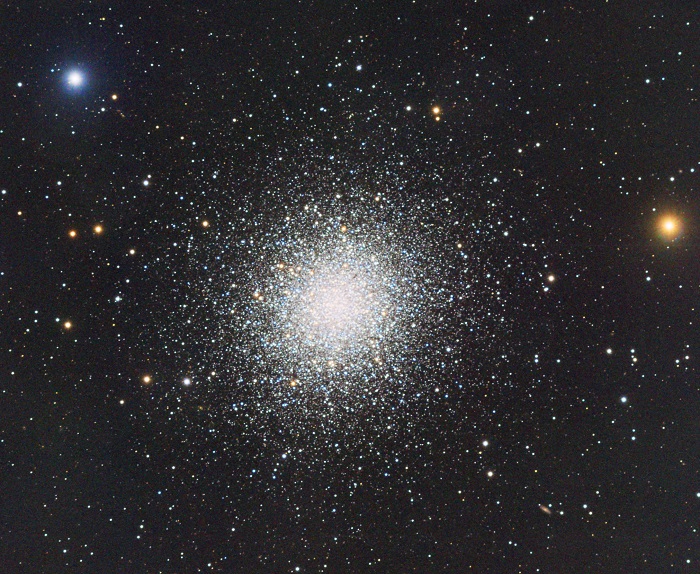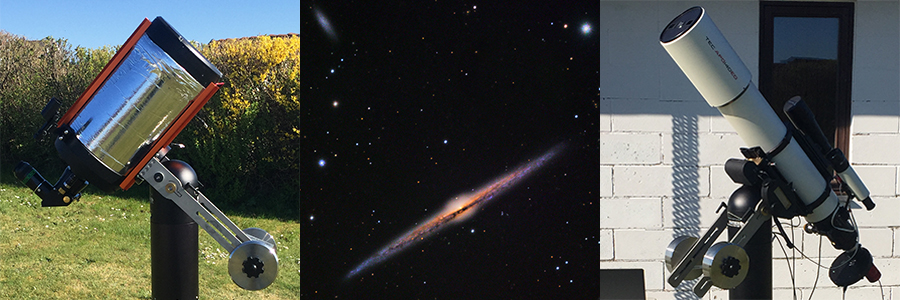
The winter sky with the many gas nebulas has disappeared in the western twilight. In an earlier post – Fast Deep Sky Imaging – I described how these large objects could be imaged with fast optical systems with limited focal length and large field of view. In springtime our view points away from the milky way arms and we get a free look to myriads of distant galaxies. Observing and imaging galaxies is a quite different matter as you can read in this post.
Galaxies and dark sky
For most unskilled visual observers Galaxies are faint hazy spots. If you try to observe galaxies from a light polluted place and don’t give you the time it takes to learn to really see these faint objects – all you will see is a faint spot – if anything at all.
If you instead brings your telescope to a rural dark sky place and take your time to really observe the galaxies you will realize that galaxies can show many details. It is possible to see spiral arms and dark dust bands.
Bring your telescope to a real dark
sky site to really enjoy Galaxies.
With the camera on the telescope this is a bit different. A dark sky is still a huge advantage but it is possible partly to compensate for a light polluted sky using filters and increased exposure time. But if you have tried to image from a dark site, you will now how much easier it is to get a good color balance and how much shorter exposure time you can use – or get much deeper with the same exposure time.
Bring your telescope to a real dark sky site to shorten exposure time and get clean colors
Galaxies and resolution
Besides for the two large exceptions M31 – the Andromeda Galaxy and M33 – the Triangulum Galaxy (and perhaps a few in the southern sky) most galaxies are rather small in the sky compared to gas nebula. Therefore we need to “zoom in” to get at better view.
Galaxies are small!
Compare Horse Head Nebula complex with Whirlpool Galaxy M51.
Visually this means more magnification. It is often seen that galaxies are observed with wide field eyepieces with low magnification. This might make the galaxies looks brighter but it is very difficult to see any details. In stead if the magnification is increased the sky will become darker and with careful examination more details within the galaxies will be visible.
I prefer to use magnifications around 75% of the telescope aperture in mm:
-
100mm telescope 75x
-
200mm telescope 150x
-
350mm telescope 262x
When you observe galaxies visually don’t be afraid to use a fairly high magnification.
Photographically resolution relates to image scale and aperture. The image scale has to be large enough to allow for the details to be recorded. To be able to get decent galaxy images an image scale around 1 – 1.5 arcsec/pixel is needed. So in most cases it means you will need a focal length around 1 meter or more. Increasing the image scale further will in most cases just lead to a fainter more noisy image with no extra details. When it comes to telescope aperture 100mm is minimum and 130mm and up is preferred.
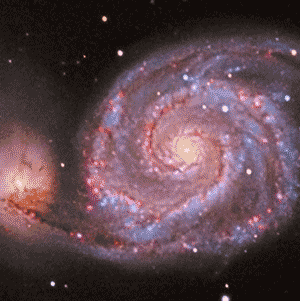
When you photograph galaxies aim for a pixel scale around 1-1.5 arcsec/Pixel
But remember tracking, focusing and seeing is usually what really sets the resolution limit.
A galaxy hunting starparty – all alone (corona time)
Luckily the lockdown in Denmark was not too harsh so it was ok for me to go to a rural place for an observation night. To really get the best of two worlds I brought both a visual setup and a photographic setup.
Short video presentation of Astrophoto setup
Astrophoto Setup
140mm f/7 (FL 980mm) TEC APO
Atik 460 sx camera with Baader LRGB filters
Televue TV60 as guide scope
TTS-160 Panther Mount with telescope rOTAtor
Short video presentation of Visual setup
Visual Setup
Celestron C9.25 SCT
13mm Televue Ethos Eyepiece, magnification 181x
TTS-160 Panther Mount
Visual results of the night
The sky turned out to be very clear and quite dark – very good for visual observations. I started in west and worked my way eastwards in the sky. Here is a list of objects I observed:
- All Messier galaxies in Leo. The Leo triplet M65, M66 and NGC 3628 was fairly easy to see. The different shapes of M65 and 66 was obvious. NGC 3628 is large but with a much lower surface brightness.
- In the Virgo cluster (in Virgo and Coma Berenices) I observed so many galaxies I can’t remember them all. I used Skysafari on my Iphone and just jumped from galaxy to galaxy. Amazingly most of the small (and to me unknown) NGC catalog galaxies were visible even though only as dim spots.
- In Ursa Major I also observed many Galaxies and the Planetary Nebula – “the Owl”. The “eyes” were visible with adverted vision.
- And just to mention a few of the “big ones”
- The “Needle galaxy” NGC 4565. Stretching across the central FOV with an outer shape as know from images. Not certain I could see the dark dust band.
- The “Black Eye Galaxy” M64. Large elongated and getting brighter towards the central parts. The dark dust cloud (the eye) visible with adverted vision.
- The “Whirlpool Galaxy” M51. The two galaxies are very easy to spot close together. In M51 there are lots of dark areas outlining the spiral arms. Quite large in the FOV.
- I ended the night observing Globular Clusters. M13 was amazing resolved to the center.
Astrophotos from the night
While I enjoyed the sky visually the AP rig was gathering photons. The main target of the night was “Markarians Chain of Galaxies”. The following subs were taken:
- 23 x 300 sec in Luminance
- 5 x 300 sec in RGB
- I ended the night by taking sky flats against the morning twilight sky.
Markarians Chain – click on image for large size.
Before the morning twilight I also shot M13 – 8 x 120 sec in RGB – click on image for larger size
